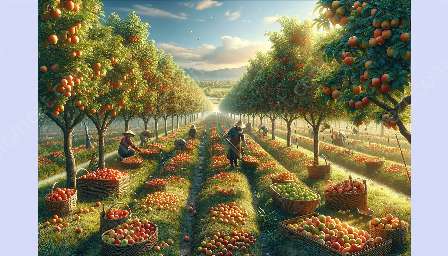As the winter months approach, fruit tree cultivation and gardening require careful attention to dormancy and winter care. Understanding the natural processes of dormancy and implementing effective care techniques can ensure the health and productivity of fruit trees and contribute to successful gardening and landscaping. In this guide, we will explore the concept of dormancy, its significance in fruit tree cultivation, and valuable tips for winter care that are compatible with gardening and landscaping needs.
The Significance of Dormancy in Fruit Tree Cultivation
Dormancy is a crucial phase in the life cycle of fruit trees. During dormancy, the trees enter a period of suspended growth and conserve their energy reserves in preparation for harsh winter conditions. This natural process is essential for the survival of fruit trees and plays a vital role in their overall health and productivity. Understanding dormancy is key to effectively managing fruit tree cultivation during the winter months.
Factors Influencing Dormancy
Several factors influence the dormancy of fruit trees, including temperature, daylight length, and genetic traits. The gradual decrease in temperature and reduced daylight hours signal the trees to enter dormancy. Different fruit tree varieties have varying dormancy requirements, and it is important to consider these factors when planning for winter care.
Preparing Fruit Trees for Dormancy
Prior to the onset of winter, it is crucial to prepare fruit trees for dormancy to ensure their well-being during the dormant period. Adequate watering, mulching, and pruning are important tasks to undertake to help the trees transition into dormancy. Properly nourished and pruned trees are better equipped to withstand the challenges of winter and emerge healthy in the following spring.
Effective Winter Care Techniques
Once fruit trees have entered dormancy, it is essential to focus on effective winter care techniques that support their well-being and resilience. Consider the following tips for successfully managing fruit tree cultivation during the winter months:
- Protection from Extreme Temperatures: Shield fruit trees from extreme cold temperatures by wrapping the trunks with protective materials and providing insulation around the root zone.
- Pruning and Maintenance: Conduct necessary pruning during dormancy to remove dead or damaged branches and promote healthy growth in the upcoming season. It is also important to inspect the trees for signs of pests and diseases and take appropriate measures to address any issues.
- Moisture Management: Monitor the moisture levels in the soil and ensure that the trees receive adequate hydration during the winter. Mulching around the base of the trees can help retain moisture and protect the roots from freezing.
- Applying Fertilizers: When appropriate and based on soil testing, consider applying fertilizers to replenish essential nutrients in the soil, supporting the trees' nutritional needs during dormancy.
Integration with Gardening and Landscaping
Dormancy and winter care techniques for fruit trees are closely linked with the principles of gardening and landscaping. The following practices can ensure a cohesive approach that benefits both fruit trees and the overall garden or landscape:
- Comprehensive Garden Cleanup: Use the winter months to perform garden cleanup, including removing debris, and clearing pathways and garden beds. This approach helps maintain a tidy and organized garden space, reducing the risk of pest and disease carryover to the next growing season.
- Soil Protection and Improvement: Implement soil protection methods such as cover cropping, adding organic matter, and applying protective mulch to enhance soil health and fertility. These practices contribute to the overall well-being of the garden and positively impact the growth of fruit trees.
- Landscape Planning and Design: Use the dormant period to plan and design landscaping features that complement fruit tree cultivation and enhance the aesthetic appeal of the outdoor environment. Consider incorporating native plants, hardscaping elements, and sustainable design principles to create a harmonious landscape.
Conclusion
Understanding the significance of dormancy and implementing effective winter care techniques are essential components of successful fruit tree cultivation and gardening practices. By prioritizing the well-being of fruit trees during the dormant period and integrating winter care with gardening and landscaping needs, individuals can create thriving outdoor spaces that yield bountiful harvests and provide visual delight throughout the seasons.




















